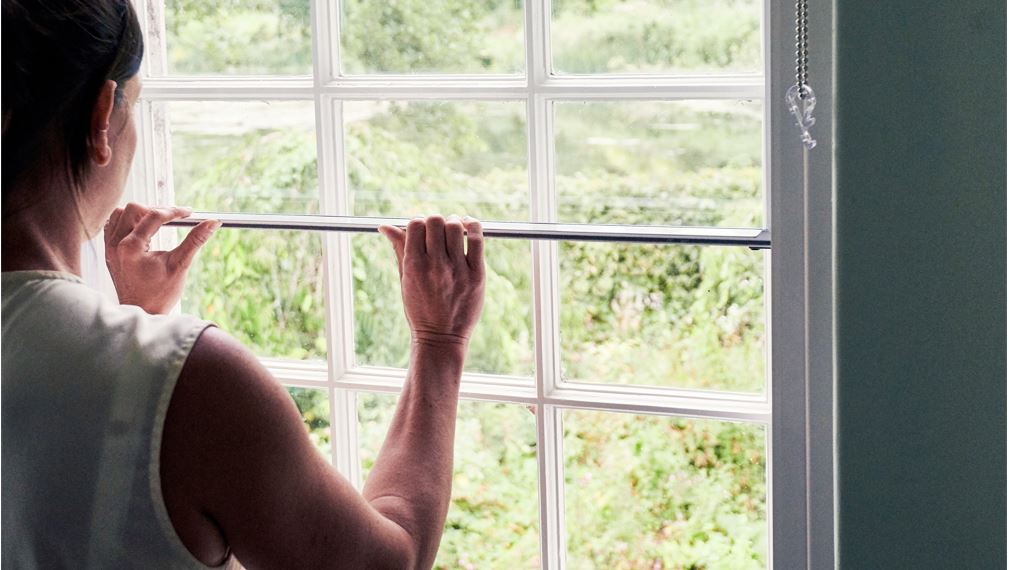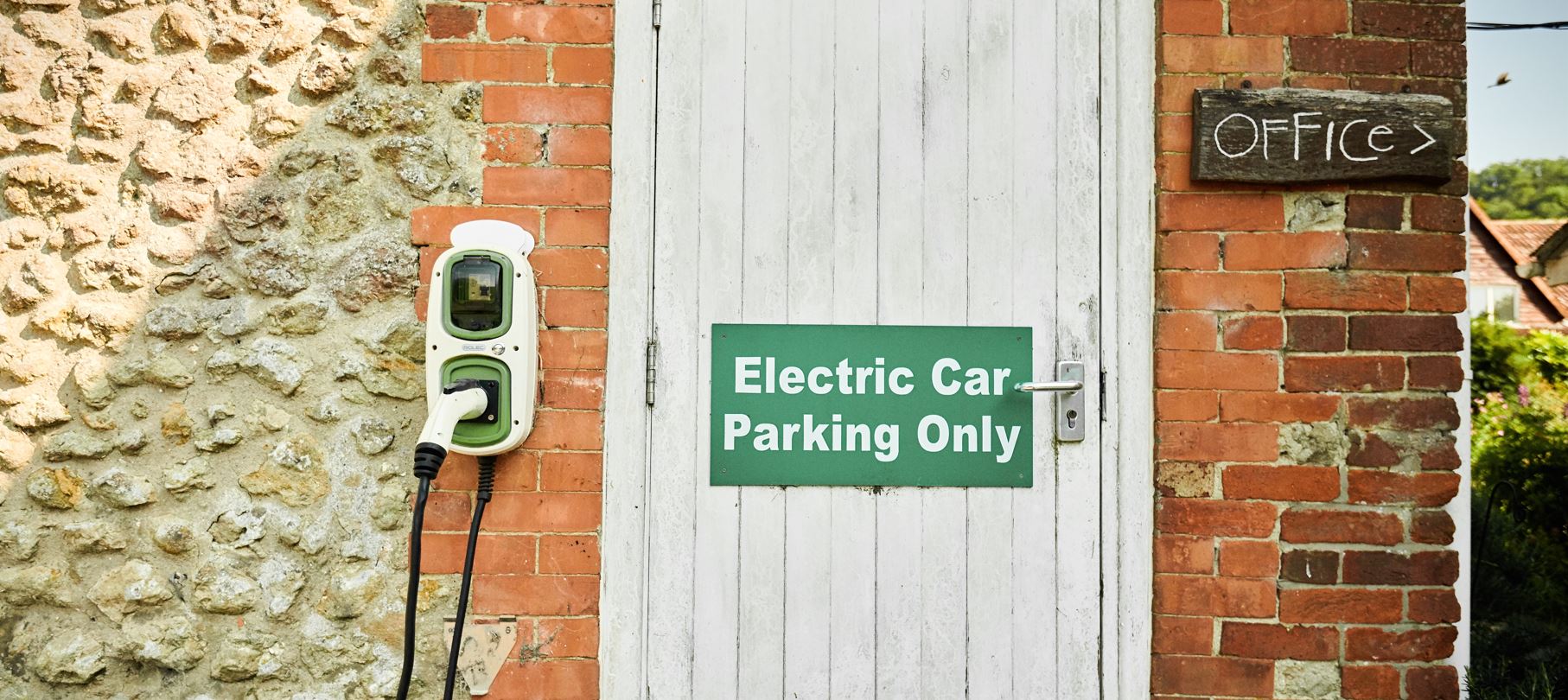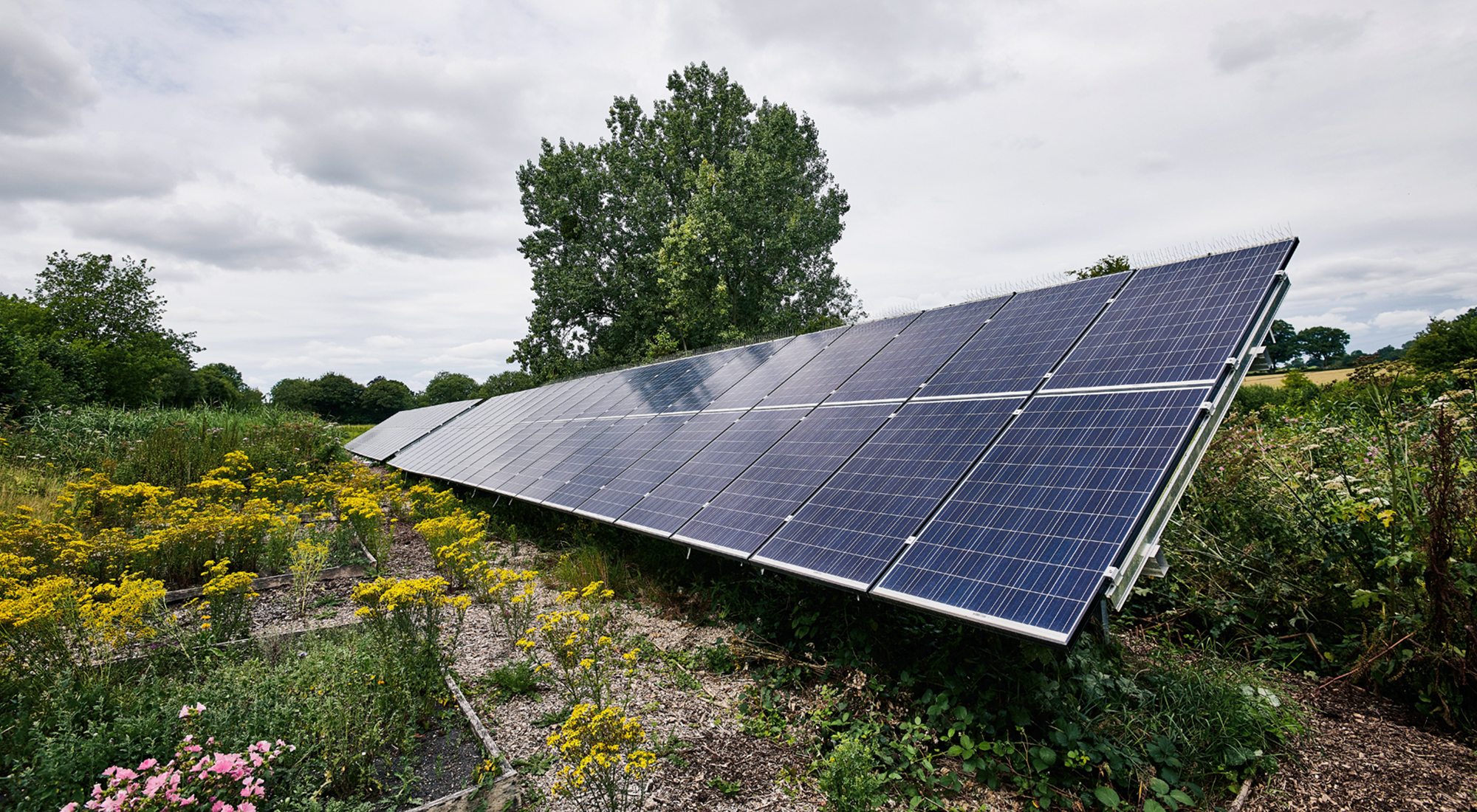We’ve put together a short guide to help you start the process of measuring your own footprint, understanding what to focus on, and deciding what measures you need to take to reduce your organisation’s emissions.
Simply follow our step-by-step guidance to start your organisation on its path to net zero.

Measuring your baseline
Before investing in any measures to reduce your carbon footprint, it’s important to first know what that footprint is.
Understanding your current energy use and footprint helps you focus on the most urgent areas to tackle, and will give you a better idea of the financial return of any potential measures you choose to install.
1. First gather up all of your energy bills
In most cases, these will be electricity and gas, but they can also include oil, LPG, petrol and diesel. If you want to do a really detailed footprint, you could collect your water, sewerage and waste bills too!
2. Next enter this data into our carbon footprint toolkit to calculate your organisation’s current emissions
You can download our toolkit here. It contains instructions, and has different options depending on how much info you have.
3. Use your results to see which areas to focus efforts on
The results sheet of the carbon footprint toolkit will highlight which areas of your operations generate the most emissions. These areas are where you should focus your attention—and where the biggest carbon savings are likely to be achieved.

Starting with the basics
It’s likely that there are lots of basic measures you can take within your organisation that will drastically reduce your organisation’s footprint.
Here are the things we think you should concentrate on first…
1. Thermal Efficiency
Thermal efficiency refers to the ability of a building to retain warmth in winter or keep cool in summer. Buildings with good thermal efficiency require less energy to artificially heat or cool.
Often the best value-for-money measures are thermal efficiency ones…
Insulation
This can be added to most walls and lofts.
- If your building has a loft… does it have 300mm of insulation in it?
- If your roof is flat… does it have insulation below the water-proof layer?
- If your roof is pitched… is there 150mm of insulation between the rafters?
- If your walls have cavities (and have not already been filled with insulation)… then we recommend you contact an experienced contractor to find out the costs and benefits of insulating
- If your walls are solid… they can often be insulated internally or externally, though this costs more than cavity wall insulation
Draft Proofing
Plugging gaps in doors and windows is a very cheap way of reducing your energy use and emissions.
Temperature Controls
Using the controls on your heating system effectively is key to making the best use of the energy that your heating generates.
Do you heat your building when not needed, like on weekends? Simple sensible setting of controls, or cheap upgrades to controls to allow more sensible settings, are excellent carbon-saving measures.
Lagging Pipes
Energy is wasted in your pipes as well as from your building as a whole. Make sure that all of your hot water pipes and any hot water tanks are properly lagged. And don’t forget to lag pipes in your plant room if you have one.
Lagging is likely to pay for itself in just a year or two!
2. Electrical Efficiency
There are several simple electricity-saving measures which also offer excellent value for money. Here’s where we suggest you start…
LED Lighting
Switching lighting to LEDs can save large amounts of energy.
Payback in 2 to 3 years
PIR Sensors
Installing passive infrared (PIR) sensors will help make sure lights are only on when they are needed. This is a great energy saving measure – especially in areas like corridors and toilets.
Offers cheap savings
Free air-cooling
If you have any consistent space cooling demand (for example a beer cellar or data/server room) then free-air cooling or ambient cooling can be used to reduce electricity demand by around 70%.
Payback in only a few years
Instrumental checks
If you have a compressed air system, performing regular instrumental checks can often detect many leaks. Replacing old compressors with modern efficient ones is also a good idea.
Fixing leaks can lead to very cheap carbon savings
3. Behaviour Change
How we behave is another key factor to consider. By making small changes to the way you and your team behave you can achieve big carbon savings. Here’s just a few changes you could start with…
- Reduce emissions from travel
Consider holding meetings and events virtually instead of face-to-face to reduce travel. Where long-distance travel is necessary, consider travelling by train instead of by air. And for short journeys, consider car sharing or public transport. For companies with a fleet of vehicles consider switching to electric vehicles and installing solar PV to charge them. - Turn everything off
Make sure any un-used devices or lights are turned off when not in use. Consider installing a central electricity kill switch so you can easily turn off all non-essential equipment and lights when they’re not needed. - Turn down the thermostat
Turning down your thermostat by just 1º will immediately save on energy and costs – and you probably won’t even feel a difference. Start at 1º and then wait a day or so to see if you notice a change, if it still feels ok then turn it down another degree and wait again. Repeat this till you and your team feel too cold, then turn it back up by 1º – this is the right temperature for your organisation. - Reduce, reuse, recycle
Make sustainability a key consideration when procuring a product or service. Purchase recycled paper and refurbished phones and IT equipment where possible. Make sure recycling bins are accessible for all staff to use. And reduce printing to a minimum (set double side printing as default for when it is required). - Employee / Volunteer Education
Make sure the whole team is on board from the start. Circulate details of any green initiatives in employee / volunteer newsletters and communications. Display tips and advice on posters and notice boards for everyone to see.
4. Renewable Energy
When it comes to renewable energy generation solar photovoltaics (PV) are often your best option. They generate electricity from the light of the sun and can be fitted on most roofs or on a ground mounted structure.
Panels must be unshaded most of the time, and cannot be facing north. They can also be fitted with diverters which enable them to heat water as well as helping power your building.
Cost: The financial returns from PV depend on when you use electricity. If you use lots of electricity when the panels are generating (during the day in the summer) they can pay for themselves in less than 5 years. If you don’t use much electricity in the day, then paybacks can be 10-15 years, or maybe longer.
To get a rough idea of how much solar PV might cost you, measure the size of your roof in square metres (from drawings, by eye, or using something like Google Maps). Divide this by 8 to get an idea of array size in kW. If this figure is below 10, multiply it by £800 to get an estimate of install cost. If it is larger, times it by £700.
5. Renewable Heat
There are two broad types of renewable heating systems; biomass and heat pumps…
Biomass
Biomass systems burn wood or other plant based material, rather than gas or oil, for heating. Providing the wood is locally and sustainably sourced, it can be argued that biomass is a carbon neutral form of heating as the trees suck down as much carbon when they grow as they emit when they are burnt.
Cost: If biomass is replacing oil or electric heating, payback can be expected in 8 to 10 years. If replacing mains gas heating, payback can be expected in 15 years or more.
Heat Pumps
Heat pumps use electricity to move heat from outside a building into it and can be very efficient. As the UK’s electricity grid continues to decarbonise, they will provide heating with a very low carbon footprint.
Heat pumps work best with oversized radiators or underfloor heating in relatively well-insulated buildings and come in two types…
- Ground-source heat pump
(more expensive but more efficient) - Air-source heat pump
(cheaper but less efficient)
Cost: Paybacks depend on circumstances and the heating system they are replacing—and can range from anything between 4 and 20 years. Properties off the gas-grid can expect to be at the lower end of this range and those on mains-gas the higher.

Sector-specific measures
Different sectors will use energy differently. In this section we outline some of the key sectors we have worked with, measures specific to those sectors and real-life case studies from projects we have supported across Dorset.
1. Factories & warehouses
Thermal Efficiency
There are very few, if any, buildings in Dorset which are as thermally efficient as possible. So all factory and warehouse buildings with heating systems should first
consider the thermal efficiency measures discussed previously.
Solar PV
Solar PV is almost always a good option for factories, who often use enough electricity to justify the expense of installing. In these circumstances, solar PV can pay for itself in 3 to 4 years.
Again, there are several excellent installation companies in Dorset who can, for free, offer a quote and business case.
Read the Renewable Energy section of this guide for tips on how to estimate the cost of installing solar PV on your roof.
LEDs
Many factories and warehouses operate for long hours and rely on artificial lighting. If this lighting is provided by anything other than the most modern T5 tubes, switching it to LEDs will save loads of energy and pay for itself in a few years.
There are several excellent LED installation companies in Dorset who can provide a survey for free and give you a quote (which will include a business case) to make a wholesale change.
Alternatively, you can buy LED replacements for existing tubes, and replace them as your existing tubes break.
Repairing Leaks
Any factory with a compressed-air system should focus on repairing leaks. Fixing leaks can lead to very cheap carbon savings.
Read case studies of Dorset factories & warehouses who have reduced their footprint…
2. Bars, pubs, cafes & restaurants
Solar PV
Any building with a constant daytime electricity demand, such as ovens, griddles, open fridges, or water heaters, would be a good candidate for a solar PV array if it had an unshaded roof which didn’t point north. Payback periods of 6 to 7 years could be expected.
See the Renewable Energy section for tips on estimating how much PV will cost.
LEDs
Many bars, pubs and restaurants operate outside of daylight hours and rely on artificial lighting. Switching existing fittings to LEDs will save lots of energy and pay for itself in a few years.
There are several excellent LED installation companies in Dorset who can provide a survey for free and give you a quote to make a wholesale change.
Alternatively, you can buy LED replacements for existing fittings, and replace them as your existing bulbs / tubes break.
Appliance Efficiency & Upgrades
Many pubs and eateries have walk-in fridges that are required to run 24/7. To save energy you can install endocube type devices in these fridges. These are simple devices that consist of a plastic casing containing a blob of wax that clamps around the temperature probe and stops it reacting to the small inrush of warm air that occurs when fridge doors are opened. As a result, the fridge will work more efficiently and save energy.
Upgrading old appliances to newer, more efficient, models will also save energy.
PIR Sensors
Pubs, bars and eateries often have areas of transient occupancy, for example – corridors, toilets and stockrooms. Installing PIR sensors to control lighting in these areas can offer cheap savings.
Thermal Efficiency
All buildings with heating systems should first consider the thermal efficiency measures discussed previously.
Read case studies of Dorset pubs, bars & eateries who have reduced their footprint…
3. Hotels & guest accommodation
Aerated shower heads
In hotels heating and hot water preparation is one of the largest operating costs and energy user. So, one way of tackling this is to use less water. Aerated shower heads work by mixing the restricted flow of water with air, therefore the water appears to come out of the showerhead in higher volume, replicating a normal shower but using 30% less water.
These shower heads can be fitted to existing shower fittings resulting in very cheap carbon savings.
Free air cooling / ambient cooling
Hotels often have beer cellars and chillers. The chilling systems use a lot of energy all year around – even though the air outside is cool enough to chill the drink for most of the year.
Free air cooling/ambient cooling is a system to exploit this, and can pay for itself in 3 or 4 years.
Solar PV
Any building with a constant daytime electricity demand would be a good candidate for a solar PV array (providing it has an unshaded roof which doesn’t point north). Payback periods of 6 to 7 years could be expected.
See Renewable Energy section for tips on estimating costs.
LEDs
Many guest houses & hotels operate outside of daylight hours and rely on artificial lighting. Switching existing fittings to LEDs will save lots of energy and pay for itself in just a few years.
PIR Sensors
Hotels and guest accommodation often have areas of transient occupancy (e.g. corridors, bathrooms, guest lounges).
Installing PIR sensors to control lighting in these areas can offer cheap savings.
Thermal Efficiency
All buildings with heating systems should first consider the thermal efficiency measures discussed previously.
Read case studies of Dorset hotels & guest accommodation who have reduced their footprint…
Coming soon
4. Leisure centres & swimming pools
Pool energy management
Most of a leisure facility’s heating demand can be attributed to the running of its swimming pools.
Switching the heating of swimming pools to a pool-specific heat pump can reduce energy bills by up to 80%.
Ventilation systems can often be modified to offer the same performance while using 100,000 kWh/yr less energy.
And a switch to variable speed pool pumps can save a reported 40% of energy use in the pool plant room.
There are two examples in Dorset of pools which have adopted these measures (Osprey Quay in Portland and Riversmeet in Gillingham).
Aerated shower heads
Using aerated shower heads is amongst the best value-for-money carbon savings available. They are low-cost and can be easily fitted to existing shower fittings.
Riversmeet leisure centre in Gillingham reports a 30% reduction in total water use across the whole centre as a result of installing aerating shower heads.
Pipe lagging in plant room
Fully lagging all pipes in a pool plant room is a simple, cheap measure which will prevent heat being lost & save energy.
Solar PV
Solar PV & LEDs are excellent options for leisure centres, due to their daytime electricity demand & need for artificial light.
See Renewable Energy section for tips on estimating PV costs & payback period.
Floodlit pitches
If lighting for any floodlit pitches is not provided by LEDs, then a conversion to them can often provide carbon savings with a relatively short financial payback.
Thermal Efficiency
All buildings with heating systems should first consider the thermal efficiency measures discussed previously.
Read case studies of Dorset leisure centres & swimming pools who have reduced their footprint…
5. Holiday & caravan parks
Pool energy management
The advice regarding swimming pools in the Leisure centres & swimming pools section applies equally well to swimming pools in holiday parks; aerated showers, heat pump heating, ventilation optimisation and pipe-lagging.
Solar PV
The energy demand patterns of parks’ central entertainment, retail and catering facilities often match solar generation well. Solar PV is often therefore a good financial as well as environmental measure, with paybacks of 4 to 5 years.
There are several excellent installation companies in Dorset who can, for free, offer a quote and business case.
See the Renewable Energy section for tips on estimating how much PV will cost to install on your available roof space.
LEDs
Many holiday parks have their own street lighting. Converting this to LEDs can pay for itself in 2 to 3 years.
There are several excellent LED installation companies in Dorset who can provide a survey for free and give you a quote (which will include a business case) to make a wholesale change.
Thermal efficiency
All buildings with heating systems should first consider the thermal efficiency measures discussed previously.
Appliance efficiency
Holiday parks often have bars, cafes and restaurants on site — see this sector’s section for advice on appliance efficiency.
Read case studies of Dorset holiday & caravan parks who have reduced their footprint…
6. Plant nurseries & garden centres
Solar PV & LEDs
Garden centres are perfect for LED lighting and solar PV, with long lighting hours and electricity demands matching solar PV generation nicely. Paybacks of under 4 years can be expected.
There are several excellent installation companies for both LEDs & solar PV in Dorset who can, for free, offer a quote and business case.
See the Renewable Energy section for tips on estimating how much available roof space you have to install solar PV and a rough estimate of how much it is likely to cost.
Thermal efficiency
Plant nurseries often use large amounts of energy to keep their plants from getting too cold. Fitting thermal screens to glasshouses can pay for itself in 5 to 8 years, but is normally the limit of what efficiency measures can be taken.
Renewable heating is therefore the most important thing to consider in these circumstances. In new glasshouses, ground -source heat pumps can be suitable, offering financial paybacks of around 8—10 years. In older buildings, biomass boilers are the better option, paying back in 10-12 years.
Read case studies of Dorset garden centres & plant nurseries who have reduced their footprint…
7. Schools
Solar PV & LEDs
We know that school budgets are always tight with many demands, but if there is any money available to be invested in the buildings, then LED lighting and solar PV are often the
best choices. There are several organisations which offer solar PV installations for free and sell the electricity to the school, though the sale price is likely to be more competitive the larger the school is.
Read case studies of Dorset schools who have reduced their footprint…
8. Village halls
Solar PV, Thermal Efficiency & LEDs
Village Halls often have large roofs which are ideal for solar PV and the large carbon savings that it offers. However, their energy use patterns mean that panels normally take a
long time to pay for themselves (around 10 years or more) since the subsidies stopped.
So, it’s often sensible for village halls to focus on heating. Many halls can have insulation added to the walls or roof. Almost all would benefit from destratification fans to blow the
warm air which lingers near the ceiling down to the occupants. More sophisticated heating controls are normally the most effective measure for Village Halls.
A simple switch to LEDs is often a quick and cheap measure that can save energy and reduce running costs for village halls. Installing PIR sensors can also save energy and prevent lights being left on when not needed by hall users.
Read case studies of Dorset village halls who have reduced their footprint…

Support for your project
Help getting started
Free technical advice is currently available to Dorset based organisations through Dorset Council’s Low Carbon Dorset programme.
This technical advice consists of up to 2-days on-site support to explore low carbon project ideas and opportunities to reduce your organisation’s carbon footprint.
This is followed by expert guidance to help get your project off the ground.
If you want to access support to explore a low carbon project idea, or for more general advice on reducing your organisation’s footprint, please complete our online form.
Subsidies and Grants
Unfortunately, there are no longer any subsidies for generating renewable electricity in the UK. But, the Smart Export Guarantee makes sure energy companies pay you something for exporting electricity to the Grid.
Smart Export Guarantee (SEG) Scheme
If you generate more electricity than you use, SEG makes sure you get some money for exporting it to the grid. The price is set by the market, and around 6p/kWh is currently the best rate (at the time of writing).
The most financially viable project are those that use the majority of electricity generated themselves. So, for Solar PV, how much electricity you use is the day during summertime will determine how financially profitable it will be.
Renewable Heat Incentive (RHI)
Prior to March 2021, eligible renewable heat installations could benefit from the Non-Domestic Renewable Heat Incentive (RHI). This scheme is now closed to new applicants.
Other funding opportunities
To keep up to date on other grant streams as and when they become available, we recommend regularly checking the following sites…
If you are a business:
If you are a charity or community group:
Checklist
We’ve created a basic checklist to help start you off on your carbon-reduction journey. Work through the steps below to reduce your organisation’s footprint…

















